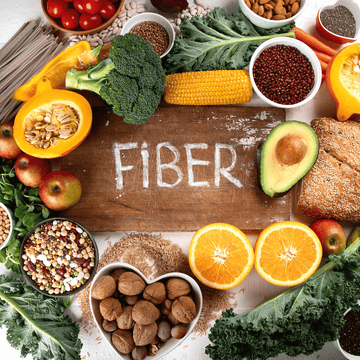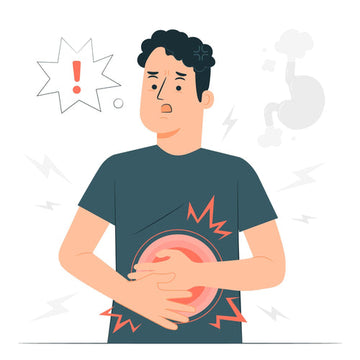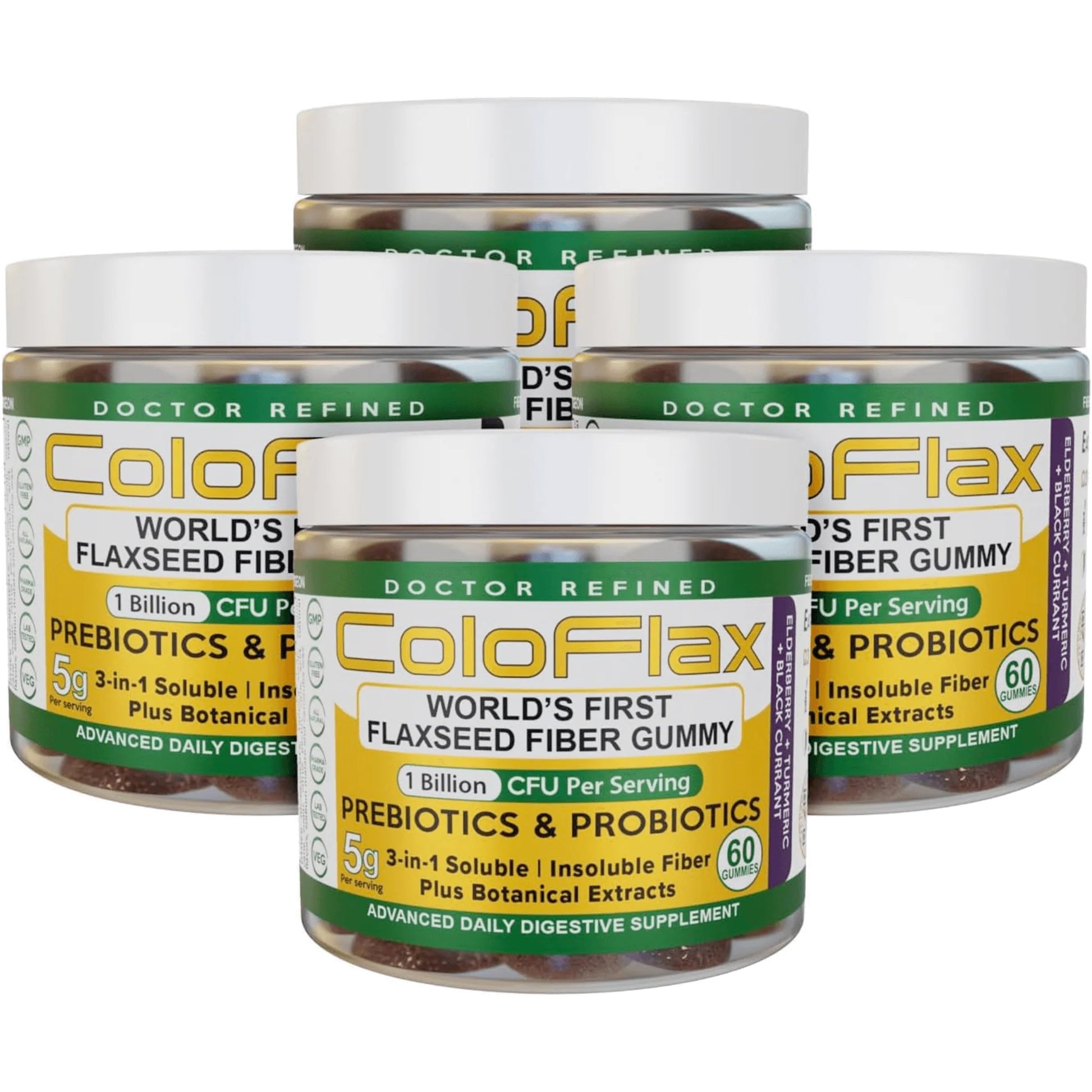The American Heart Association recommends consuming between 25 and 30 grams of fiber a day, a requirement that 95% of Americans don’t meet. With this amount of fiber in your diet, your risk of heart disease, colon cancer, and other chronic conditions is greatly reduced.(1)
In this guide, we’ll talk about the benefits of a high-fiber diet while also discussing the foods that can help you to meet your targets.
What are the Benefits of a High Fiber Diet?
We tend to think of fiber as something that makes you more regular, but it’s much more than that.
Adding more fiber to your diet could add years to your life.
Here’s how:
It Can Keep You Regular
If you have been constipated for more than a few days at a time, or you have ever suffered from heavy bloating, gas, and intermittent constipation/diarrhea as a result of your diet and lifestyle, you can appreciate the importance of staying regular. It can make a massive difference to everything from your mental health to your energy levels.
Fiber can help to push waste out of the gut, creating more volume and drawing water into the colon. It draws bad bacteria out of the gut, cleans everything up, and ensures that everything is healthy down there.
Fiber also slows down the passage of waste, so it’s just as effective at treating diarrhea as it is at treating constipation.
It Can Help with Weight Regulation
On paper, weight loss is very simple. It’s calories in vs calories out. If you consume less than you use, you’ll lose weight.
In practice, however, it’s much more complicated, as you have to deal with the constant threat of hunger. It’s easy to tell yourself that you need to eat less, but when you try and hunger strikes, it’s a hard promise to keep.
Fiber could help with this.
Research suggests that individuals who consume more fiber are better at managing their weight.(2) Fiber slows the transit of waste through the colon and it also absorbs more water, thus filling you up. When you’re full, you’re not hungry, and so you’re less likely to binge on high-fat and high-sugar foods.
It Can Help with Blood Sugar Management
Fiber could play a major role in controlling blood sugar levels. According to a study conducted in 2008, dietary fiber can “inhibit macronutrient absorption, reduce postprandial glucose response, and beneficially influence certain blood lipids”. The CDC has also published some fascinating resources on using fiber in the management of diabetes.(3)(4)
There are a few different mechanisms of action here. First, as noted above, fiber makes you feel fuller for longer, thus keeping cravings low and helping to prevent weight gain, a key factor in the development of diabetes.
Secondly, your body can’t absorb and digest fiber in the same way as other nutrients, so it doesn’t cause your blood sugar to spike. This means that adding high-fiber foods (see below) to your daily meals can help you to keep your blood sugar under control.
Fiber Reduces the Risk of Heart Disease and Cancer
Some of the most exciting research into the benefits of fiber concern its impact on heart disease and cancer risk. These are the two bigger killers in the United States.(5)
Several studies have shown an inverse association between colorectal cancer and high-fiber diets, which means that the more fiber an individual consumes, the less likely they are to develop this disease.(6) It could also reduce the prevalence of other cancers, particularly those associated with the digestive tract.
This could be linked to reduced incidences of constipation, diarrhea, and other digestive issues.
Furthermore, a large-scale analysis from 2003 studied the diets and lifestyles of nearly 10,000 adults over a period of 19 years. It looked at the incidences of coronary heart disease (CHD) and cardiovascular disease (CVD) during this period and noted that those consuming higher levels of soluble fiber reported fewer incidents of these diseases.
The study concluded that “A higher intake of dietary fiber, particularly water-soluble fiber, reduces the risk of CHD.”
Fiber Can Prolong Your Life
Thanks to all of the benefits highlighted above, eating more fiber could prolong your lifespan. After all, if you’re less likely to get heart disease, colon cancer, and diabetes, you’re equipped to deal with some of the biggest health problems facing Americans today.
We’re not just making assumptions, either. There have been a number of studies looking at the effects of fiber on longevity and most have been extremely positive.
For instance, an analysis conducted in 2011 used the NIH-AARP Diet and Health Study to measure the effects of dietary fiber on mortality. Food frequency questionnaires were conducted at baseline and results were followed up over a number of years.(7)
Researchers found that “Dietary fiber intake was associated with significantly lowered risk of total death in both men and women”. It concluded that the risk of death from cardiovascular, infectious, and respiratory diseases was reduced by as much as 56% in men and 59% in women.
What High-Fiber Foods Should you Add to your Diet?
Now that we know what fiber can do for your body, one question remains: What are the best high-fiber foods?
There are two things to consider when looking for high-fiber foods. The first is the actual fiber content, keeping in mind that the closer you get to that 30g goal, the better.
The second is how much fiber you get compared to the calories. After all, if we just focus on fiber, you’ll find twice as much in a Big Mac as you will in a tangerine, but the former contains over 560 calories and stacks of saturated fat while the latter has fewer than 50 calories.
Here’s a table of high-fiber foods to help you:
|
Food |
Fiber Per 100g |
Fiber Per 100 Calories |
Calories Per 100g |
|
Chia Seeds |
34g |
7g |
490 |
|
Flax Seeds |
27g |
5g |
534 |
|
Pumpkin Seeds |
18g |
4g |
446 |
|
Dried Coconut |
16g |
2.5g |
660 |
|
Sesame Seeds |
14g |
2.5g |
567 |
|
Almonds |
13g |
2g |
578 |
|
Navy Beans |
11g |
7.5g |
337 |
|
Pine Nuts |
11g |
1.5g |
673 |
|
Pistachios |
11g |
2g |
557 |
|
Dark Chocolate |
10.9g |
2g |
543 |
|
Oats |
10.1g |
2.8g |
389 |
|
Passion Fruit |
10g |
10.5g |
97 |
|
Hazelnuts |
10g |
1.5g |
628 |
|
Pecans |
10g |
1.5g |
691 |
|
Macadamia Nuts |
9g |
1g |
718 |
|
Sunflower Seeds |
9g |
1.5g |
570 |
|
Split Peas |
8.3g |
7.4g |
125 |
|
Peanuts |
8g |
1.5g |
567 |
|
Brazil Nuts |
8g |
1g |
682 |
|
Chickpeas (Garbanzo Beans) |
7.6g |
3.3g |
164 |
|
Lentils |
7.3g |
3g |
165 |
|
Avocados |
7g |
4g |
160 |
|
Raspberries |
7g |
12.5g |
52 |
|
Kidney Beans |
6.8g |
7.5g |
337 |
|
Green Peas |
6g |
6.5g |
81 |
|
Lima Beans |
5g |
4.5g |
95 |
|
Artichokes |
5g |
11.5g |
46 |
|
Parsnips |
5g |
6.5g |
75 |
|
Guavas |
5g |
8g |
68 |
|
Blackberries |
5g |
12.5g |
43 |
|
Chestnuts |
5g |
2g |
204 |
|
Kale |
4g |
11g |
50 |
|
Acorn Squash |
4g |
8g |
40 |
|
Collard Greens |
4g |
12g |
30 |
|
Whole Wheat Pasta |
4g |
2.5g |
159 |
|
Pomegranate |
4g |
5g |
68 |
|
Persimmon |
4g |
5g |
70 |
|
Butternut Squash |
3g |
8g |
45 |
|
Carrots |
3g |
8.5g |
41 |
|
Beet Greens |
3g |
10.5g |
22 |
|
Brussel Sprouts |
3g |
7g |
43 |
|
Green Beans |
3g |
9g |
31 |
|
Okra |
3g |
11.5g |
31 |
|
Sweet Potatoes |
3g |
3.5g |
91 |
|
Eggplant |
3g |
7g |
31 |
|
Cabbage |
3g |
10g |
24 |
|
Broccoli |
3g |
9.5g |
34 |
|
Kiwi Fruits |
3g |
5g |
61 |
|
Pears |
3g |
5.5g |
55 |
|
Bananas |
3g |
3g |
89 |
|
Starfruit |
3g |
9g |
31 |
|
Spinach |
2g |
10.5g |
23 |
|
Swiss Chard |
2g |
10.5g |
19 |
|
Baked Potatoes |
2g |
2.5g |
109 |
|
Asparagus |
2g |
9g |
20 |
|
White Button Mushrooms |
2g |
8g |
18 |
|
Turnips |
2g |
9g |
28 |
|
Sweetcorn |
2g |
2.5g |
86 |
|
Cauliflower |
2g |
8g |
25 |
|
Leeks |
2g |
3g |
61 |
|
Celery |
2g |
11.5g |
14 |
|
Lettuce |
2g |
12.5g |
14 |
|
Oranges |
2g |
5g |
47 |
|
Blueberries |
2g |
4g |
57 |
|
Tangerines |
2g |
3.5g |
53 |
|
Strawberries |
2g |
6.5g |
32 |
|
Cherries |
2g |
3.5g |
63 |
|
Apricots |
2g |
4g |
48 |
|
Apples |
2g |
4.5g |
52 |
|
Mangoes |
2g |
2.5g |
65 |
|
Papaya |
2g |
4g |
39 |
|
Nectarines |
2g |
4g |
44 |
|
Peaches |
2g |
4g |
39 |
Is Soluble Fiber or Insoluble Fiber Best for Health?
There are two types of dietary fiber: soluble and insoluble. The former dissolves in water and creates bulky stools. The latter doesn’t dissolve and passes through the gut undigested. Both of these types of fiber are needed for a healthy gut, along with prebiotics (from prebiotic fiber like inulin) and probiotics (from fermented foods).
As far as health benefits are concerned, the most noteworthy studies have been conducted on soluble fiber. This was the type of fiber used in many studies relating to coronary heart disease.
But insoluble fiber is also needed to promote regularity and prevent straining. Both types of fiber can help with blood sugar management and both have been studied for their benefits in protecting against colon cancer.
Is it Good to Eat Fiber Every Day?
Yes! Fiber is not something you should only eat a couple of times a week like oily fish. It’s something that you should be consuming on a daily basis. Of course, that doesn’t mean you won’t reap the benefits of fiber if you miss your requirement for a single day. The occasional low-fiber day won’t hurt you.
But if you can eat 25g to 30g of fiber every day, you definitely should.
Can Lots of Fiber Make Your Bloated?
One of the things that deters people from eating a high-fiber diet is that they overdo it. They hear about the benefits of fiber, and they switch from a low-fiber diet to one where they are consuming 40 grams or more a day.
The result is a few days of uncomfortable bloating and gas that sends them back to their processed foods.
Anytime you undergo such a significant dietary shift, you’ll feel the effects. That’s why it’s best to take things easy. Try to aim for around 25 to 30 grams, and if you’re used to a diet of less than 10g, don’t exceed that recommendation.
Drinking lots of water and getting plenty of exercise will also help to reduce the discomfort in those initial days.
Summary: The Benefits of a High-Fiber Diet
According to experts, over 95% of Americans don’t consume enough fiber. You will struggle to find another macro or micronutrient in which we are so heavily deficient. And yet it’s something that most of us are ignoring, assuming that fiber is not really that important and that its only purpose is to make our bathroom habits more regular.
But as the above guide shows, increasing your fiber consumption could have a massive impact on your life and health.
In fact, many of the biggest health issues that the US is facing now can be improved with a higher fiber intake. Heart disease, colon cancer, diabetes, obesity—fiber won’t fix these issues, but if everyone got their fill, the prevalence of such issues would surely decrease.
References
- https://www.ahajournals.org/doi/full/10.1161/01.cir.95.12.2701
- https://pubmed.ncbi.nlm.nih.gov/11396693/
- https://pubmed.ncbi.nlm.nih.gov/18287346/
- https://www.cdc.gov/diabetes/library/features/role-of-fiber.html
- https://www.cdc.gov/nchs/fastats/leading-causes-of-death.htm
- https://pubmed.ncbi.nlm.nih.gov/26269366/
- https://www.ncbi.nlm.nih.gov/pmc/articles/PMC3513325/






